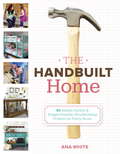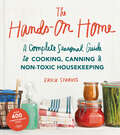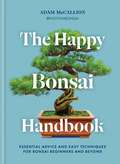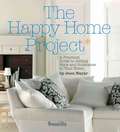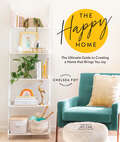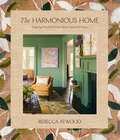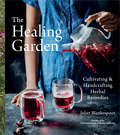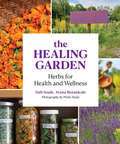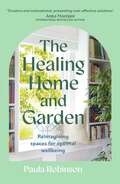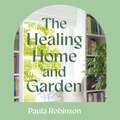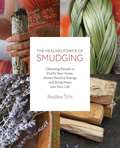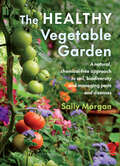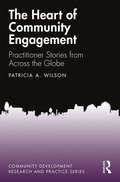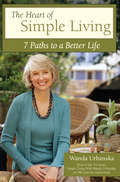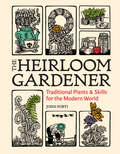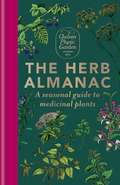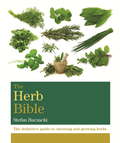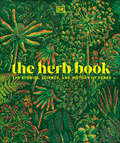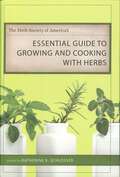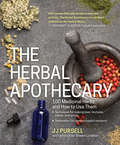- Table View
- List View
The Handbuilt Home: 34 Simple Stylish and Budget-Friendly Woodworking Projects for Every Room
by Ana WhiteCreate a Beautiful, Modern Home with One-of-a-Kind DIY FurnitureBeds, organizers, Adirondack chairs, a play table, and more! It's easy to build inexpensive, quality furnishings with this indispensible collection of woodworking projects from Ana White, the popular blogger who has inspired millions of homemakers with her stylish furniture plans and DIY spirit. As a young mom on a tight budget, Ana learned to make her own well-designed pieces inspired by the styles in her favorite stores--saving thousands of dollars in the process.Now, in this reference for woodworkers of all skill levels, Ana shares everything she has learned along the way. Inside The Handbuilt Home you'll find:* Plans for 34 versatile furniture projects for every room in your house--from beginner-friendly home accessories to sturdy tables, a media center, kids' items, and storage solutions* Comprehensive information on using off-the-shelf lumber and basic equipment--almost every project can be made with a drill, a saw, and some hand tools* Easy-to-follow instructions, costs, and time estimates to guide even the most amateur of carpenters through any projectYou don't need to be physically tough or superstrong to make your own furniture, and it's okay if you don't know that a 2x4 doesn't actually measure 2 by 4 inches. All you need is the determination to create a better home for yourself or your family and the confidence to say, "I can build that." Also available as an eBook
The Hands-On Home
by Charity Burggraaf Erica StraussWant to create an organized, productive, and beautiful kitchen and home? Popular Seattle blogger, Erica Strauss (Northwest Edible Life) shows us how in this modern homekeeping handbook for thrifty DIYers who care about sustainability. A fresh take on modern homemaking, this is a practical (and sometimes sassy) guide to maximizing your time, effort, and energy in the kitchen and beyond. With a focus on less consumerism, it will teach you how to organize your kitchen and home to make the best use of your time. For those yearning to live a more ecologically minded, grounded lifestyle, this book is full of practical, no-nonsense advice, fabulous recipes, and time- and money-saving techniques.From the Hardcover edition.
The Happy Bonsai Handbook: Essential advice and easy techniques for bonsai beginners and beyond
by Adam McCallionUnlock the secrets to beautifully balanced bonsai with this comprehensive guide. Organized into seven chapters, this handbook serves as an indispensable companion for newbie and experienced bonsai enthusiasts alike.For beginners, Adam shares his heartbreak over the death of his first bonsai, and explains how it spurred him on to ensure the same thing never happened again - plus his top tip for beginners buying their first tree. For more knowledgeable fans, Adam shares tips and techniques to take tree styling to the next level, and ideas for different trees to try growing next.The Happy Bonsai Handbook provides concise and expert solutions, backed up with practical tips, personalized advice, and stunning photography. Illustrations and step-by-step photographic sequences will also ease readers on their journey to becoming successful bonsai parents.Adam McCallion copies the style of his well-loved instructional videos to deliver information in a simplified, upbeat and easy-to-follow manner. This book will be turned to again and again by a bonsai fan as their collection grows and develops. Whether seeking to revive an inherited specimen or to grow a tree from scratch, this book is your ultimate guide to enjoying the mini-tree lifestyle.
The Happy Home Project
by Jean NayarWe all want beautiful homes that reflect our personal style. But the happiest homes don't just look good-they also feel good. Ideally, they support the way we live, keep us healthy and safe and enrich our net worth, too. So how do we create homes that truly make us happy? In The Happy Home Project, author Jean N ayar looks not only at the material things that contribute to the beauty and style of a house, but also explores the hidden elements and intangibles that add to its substance and soul. Brimming with beautiful photos and filled with expert advice from architects, designers, organizing experts, and contractors, the book offers easy-to-follow guidance on how to create inspiring, stylish rooms as well as practical tips on how to invest wisely in furniture and improvements that will add value to your home-and your quality of life. Focusing on comfort and harmony with nature, the book taps into the wisdom of poets, philosophers and social scientists-as well as experts of the ancient Asian building philosophies of feng shui, vastu shastra, and wabi-sabi-to reveal some of the subtler steps that anyone can take to turn to an ordinary, impersonal house into an uplifting, personal sanctuary.With helpful hints on everything from corralling clutter, picking paint and arranging furniture to refinishing floors, replacing windows and remodeling a kitchen, The Happy Home Project is a great go-to guide for home improvement projects, large and small. Whether your home needs a major makeover or just a little fine-tuning, the ideas, solutions and tips in this book will help you increase its happiness quotient-and let you live well in any dwelling and at any stage of life.
The Happy Home: The Ultimate Guide to Creating a Home that Brings You Joy
by Chelsea FoyThis lovely and inspirational guide, organized around six joyful qualities, will show you how to create a happier home, through prompts, quick fixes, afternoon projects, and mindful design and organization—The Happy Home is not just a title, it&’s a promise.Energize. Uplift. Comfort. Calm. Empower. Express. The road to happiness is paved with good emotions. In fact, a happy home is infused with these six actions and this cheerful book will help you create a space you love and that loves you back. Lovely Indeed creator Chelsea Foy offers up more than 50 creative ideas to engage all the senses to brighten your mood throughout your home. This book sits at the intersection of HGTV home improvements and design, thoughtful Marie Kondo practices, and a cheery color palette fans of the Home Edit will love.Kicking off with a foreword by Joy Cho, creator of Oh Joy!, the book guides you through questions to consider so you can customize your home to your own mood-lifting needs, be it a calming bedroom, a chill den, or an energizing kitchen. Easy projects and ideas help you tweak the rooms of your house so they engage the senses in all the right ways.Each chapter focuses on a feeling and includes: Guided prompts: Questions to consider about what a happy space might look and feel like for youQuick Tricks: Creative hacks and ideas to freshen up your spaceAfternoon Projects: Doable projects and inspo for your home and décor to amp up the joy Big Ideas: Step-by-step projects that you can complete in a day or weekend that are inexpensive but go a long way to creating a home tailored to your tastes and happiness needs With this handy and cheery book, you'll quickly find ways to customize all the rooms in your house for maximum bliss.
The Harmonious Home: Designing Peaceful, Personal Spaces Inspired by Nature
by Rebecca AtwoodA holistic approach to creating a home using the colors, patterns, and textures found in the natural world, from the author of Living with Color and Living with Pattern.Hailed by Vogue for her "approachable patterns and textiles" Rebecca Atwood shares a new method for styling your interiors, one guided by nature: specifically landscapes that capture your imagination. As an artist, she has found that the details of a landscape helps make design accessible, and when decorating a home, it can even direct the decisions you make. Think of a place outside that contains a mood you want to bring into your home, such as the beach or a garden you saw on your travels. Identify the colors in its landscape and you can choose a room&’s paint colors. Pick out its textures and you can decide what materials—rugs, wallpaper, upholstery fabric—to bring into the room. The Harmonious Home walks you through six different landscapes—Dunes, Ocean, Field, Forest, Garden, and City—and shows you how to pull together color and pattern combinations you might not have imagined on your own that evoke the feeling of the place without looking overly thematic.Throughout, you&’ll find gorgeous photographs of interiors around the country and expert advice from celebrated interior designers for selecting lighting, a floor plan, window treatments, and more. With endless inspiration for building a room around a mood, The Harmonious Home takes you from fabric and paint swatches to a harmonious design that feels like home.
The Healing Garden: Cultivating and Handcrafting Herbal Remedies
by Juliet BlankespoorA comprehensive and lushly photographed guide to growing and using healing plants, including recipes, from the founder of the Chestnut School of Herbal MedicineThis is the ultimate reference for anyone looking to bring the beauty and therapeutic properties of plants into their garden, kitchen, and home apothecary. Both informative and accessible, it covers how to plan your garden (including container gardening for small spaces); essential information on seed propagation, soil quality, and holistic gardening practices; 30 detailed profiles of must-know plants (including growing information, medicinal properties, and how to use them); foundational principles of herbalism; step-by-step photographic tutorials for preparing botanical medicine and healing foods; and 70 recipes for teas, tinctures, oils, salves, syrups, and more. Packed with sumptuous photography, this book will appeal to home gardeners who want to branch out to culinary and medicinal herbs, home cooks and those interested in natural wellness, and novice and skillful herbalists alike.
The Healing Garden: Herbal Plants for Health and Wellness
by Deb SouleIn The Healing Garden, Deb Soule, founder of Avena Botanicals, offers an inspiring guide to herb gardening and crafting herbal remedies that promote wellness of spirit and body. Soule combines her passion for plants gardens, and healing with her extensive experience working with medicinal herbs, flowers, roots, and berries. Her practical advice addresses each aspect of fostering a garden filled with helpful, healing plants: biodynamic gardening practices; gathering plants and setting up a drying room; and creating herbal teas, decoctions, tinctures, syrups, tonics, vinegars, essences, and more. A chapter outlining eighteen medicinal herbs provides detailed information on their cultivation and healing properties. Molly Haley's colorful photography showcases Avena Botanicals' lush herb gardens in all seasons. The Healing Garden is grounded in respect for the interconnectedness of all living beings and is an eloquent plea for spiritual awareness and the wholeness of individuals, communities, and our planet.
The Healing Home and Garden: Reimagining spaces for optimal wellbeing
by Paula RobinsonAre you tired of formulaic interiors and following trends? Do you long for a home that expresses who you truly are, that's a sanctuary from our 24/7 lifestyles dominated by technology?The Healing Home & Garden will help you to:- Take an objective look at your home - Examine whether it's supporting your mental and physical wellbeing - Identify how it may be perpetuating unhealthy habits like: working all hours, eating on the run, poor sleep and spending too much time indoors - Tap into your intuition to create a healing environment that will ultimately make you happier, less stressed and healthier - Reconnect with the restorative power of natureThe Healing Home & Garden is for everyone - no matter your budget, whether you rent or own, live in a bedsit or a mansion. No major building works are involved, just a call to follow your own intuition and create the home that's right for you - not the style police! This book is full of budget tips for rethinking your living space, creative suggestions for re-purposing furniture and objects, and extensive product and book recommendations."Paula Robinson is at the leading edge of new systems of awareness about the spaces we inhabit... a treasure trove of practical, step-by-step guidance"Jean Haner, author of Clear Home Clear Heart: Learn to Clear the Energy of People and Places
The Healing Home and Garden: Reimagining spaces for optimal wellbeing
by Paula RobinsonAre you tired of formulaic interiors and following trends? Do you long for a home that expresses who you truly are, that's a sanctuary from our 24/7 lifestyles dominated by technology?The Healing Home & Garden will help you to:- Take an objective look at your home - Examine whether it's supporting your mental and physical wellbeing - Identify how it may be perpetuating unhealthy habits like: working all hours, eating on the run, poor sleep and spending too much time indoors - Tap into your intuition to create a healing environment that will ultimately make you happier, less stressed and healthier - Reconnect with the restorative power of natureThe Healing Home & Garden is for everyone - no matter your budget, whether you rent or own, live in a bedsit or a mansion. No major building works are involved, just a call to follow your own intuition and create the home that's right for you - not the style police! This book is full of budget tips for rethinking your living space, creative suggestions for re-purposing furniture and objects, and extensive product and book recommendations."Paula Robinson is at the leading edge of new systems of awareness about the spaces we inhabit... a treasure trove of practical, step-by-step guidance"Jean Haner, author of Clear Home Clear Heart: Learn to Clear the Energy of People and Places
The Healing Home and Garden: Reimagining spaces for optimal wellbeing
by Paula RobinsonAre you tired of formulaic interiors and following trends? Do you long for a home that expresses who you truly are, that's a sanctuary from our 24/7 lifestyles dominated by technology?The Healing Home & Garden will help you to:- Take an objective look at your home - Examine whether it's supporting your mental and physical wellbeing - Identify how it may be perpetuating unhealthy habits like: working all hours, eating on the run, poor sleep and spending too much time indoors - Tap into your intuition to create a healing environment that will ultimately make you happier, less stressed and healthier - Reconnect with the restorative power of natureThe Healing Home & Garden is for everyone - no matter your budget, whether you rent or own, live in a bedsit or a mansion. No major building works are involved, just a call to follow your own intuition and create the home that's right for you - not the style police! This book is full of budget tips for rethinking your living space, creative suggestions for re-purposing furniture and objects, and extensive product and book recommendations."Paula Robinson is at the leading edge of new systems of awareness about the spaces we inhabit... a treasure trove of practical, step-by-step guidance"Jean Haner, author of Clear Home Clear Heart: Learn to Clear the Energy of People and Places
The Healing Power of Smudging: Cleansing Rituals to Purify Your Home, Attract Positive Energy and Bring Peace into Your Life
by Rodika TchiA DIY guide to cleansing your home of negative energy with the power of the ancient art of smudging—includes photos. Invite happiness and power into your life! Sharing the ancient tradition of space clearing with sacred smoke, this comprehensive introduction to smudging teaches you how to empower your life, your home, and your heart. With step-by-step tutorials, colorful photos, and expert advice, this book makes it easy to: • Smudge your home, yourself, and others • Craft your own smudge stick and fan • Choose sacred herbs, oils, and resins • Select the ideal day and time to smudge • Add crystals to your smudging alter • Perform rituals for all occasions
The Healthy Vegetable Garden: A natural, chemical-free approach to soil, biodiversity and managing pests and diseases
by Sally MorganWhether you’re an experienced gardener, homesteader, or market farmer, this A–Z, soil-to-table guide shows you how to reduce chemical inputs; naturally enrich your growing ecology; and create a hardy, nutrient-dense, and delicious crop. "There are few gardeners (or farmers) I know who wouldn’t benefit from reading Sally Morgan’s new book. . . . The Healthy Vegetable Garden is a detailed and indispensable resource."—Hobby Farms In The Healthy Vegetable Garden, expert organic gardener Sally Morgan explains how to use natural approaches to cope with the challenges of a changing climate through principles from regenerative gardening, agroecology, and permaculture—all to help your green space thrive. The Healthy Vegetable Garden shows you how to: Combat disease and keep pests at bay with natural predators, companion planting, and trap and barrier crops Choose the right plants to attract pollinators and pest predators Build a healthy soil full of organic matter, earthworms, and mycorrhizal fungi Regenerate soil through no-dig practices, composting, cover crops, and mulching Boost biodiversity through the use of crop rotations and polyculture Rewild your garden by creating a range of habitats, making use of walls and fences, log piles, water features, and wild corners Understand plant defenses and use biocontrols Make natural barriers, traps, and lures A healthy, productive garden should work in harmony with nature to produce and protect delicious fruits and vegetables and build a rich soil that is full of life. With The Healthy Vegetable Garden, growers of all levels will start reducing incidents of pests and diseases while creating a verdant habitat—all without the need for fertilizers, pesticides, or weedkillers.
The Healthy Vegetable Garden: A natural, chemical-free approach to soil, biodiversity and managing pests and diseases
by Sally MorganWhether you&’re an experienced gardener, homesteader, or market farmer, this A–Z, soil-to-table guide shows you how to reduce chemical inputs; naturally enrich your growing ecology; and create a hardy, nutrient-dense, and delicious crop."There are few gardeners (or farmers) I know who wouldn&’t benefit from reading Sally Morgan&’s new book. . . . The Healthy Vegetable Garden is a detailed and indispensable resource."—Hobby Farms In The Healthy Vegetable Garden, expert organic gardener Sally Morgan explains how to use natural approaches to cope with the challenges of a changing climate through principles from regenerative gardening, agroecology, and permaculture—all to help your green space thrive.The Healthy Vegetable Garden shows you how to:• Combat disease and keep pests at bay with natural predators, companion planting, and trap and barrier crops• Choose the right plants to attract pollinators and pest predators• Build a healthy soil full of organic matter, earthworms, and mycorrhizal fungi• Regenerate soil through no-dig practices, composting, cover crops, and mulching• Boost biodiversity through the use of crop rotations and polyculture• Rewild your garden by creating a range of habitats, making use of walls and fences, log piles, water features, and wild corners• Understand plant defenses and use biocontrols• Make natural barriers, traps, and luresA healthy, productive garden should work in harmony with nature to produce and protect delicious fruits and vegetables and build a rich soil that is full of life. With The Healthy Vegetable Garden, growers of all levels will start reducing incidents of pests and diseases while creating a verdant habitat—all without the need for fertilizers, pesticides, or weedkillers.
The Heart of Community Engagement: Practitioner Stories from Across the Globe (Community Development Research and Practice Series)
by Patricia A. WilsonDrawing on first-hand accounts of action research in the Americas, Africa, and Asia, The Heart of Community Engagement illustrates the transformative learning journeys of exemplary catalysts for community-based change. Practitioners’ stories of community engagement for social justice in the Global South elucidate the moments of insight and transformation that deepened their practice: how to deal with uncertainty, recognize their own blind spots, become aware of what is emergent and possible in the moment, and weave an inclusive bond of love, respect, and purpose. Each successive narrative adds a deeper level of understanding of the inner practice of community engagement. The stories illuminate the reflective, or inner, practice of the outside change agent, whether a planner, designer, participatory action researcher, or community development practitioner. From a shantytown in South Africa, to a rural community in India, or an informal settlement in peri-urban Mexico, the stories focus attention on the greatest leverage point for change that we, as engaged practitioners, have: our own self-awareness. By the end of the book, the practitioners are not only aware of their own conditioned beliefs and assumptions, but have opened their minds and hearts to the complex and dynamic patterns of emergent change that is possible. This book serves as a much-needed reader of practice stories to help instructors and students find the words, concepts, and examples to talk about their own subjective experience of community engagement practice. The book applies some of the leading-edge concepts from organizational development and leadership studies to the fields of planning, design, and community engagement practice. Key concepts include the deep dive of sensing the social field, seeing the whole, and presencing the emergent future. The book also provides a creative bridge between participatory action research and design thinking: user-based design, rapid prototyping, and learning from doing.
The Heart of Simple Living: 7 Paths to a Better Life
by Wanda UrbanskaThe Heart of Simple Living is your road map to a more balanced life - a life centered on self-discovery. Fewer possessions. More time. More friends. More meaning. This book will help you identify objectives for your life and create awareness of your actions and finances, while planning for your future.This inspirational book delivers seven tangible and actionable paths, woven together with real-life stories and humor along the way. You can follow these paths sequentially or cherry-pick them one at a time. Pursuing a life of simplicity is a journey, and as you blaze the trail to your simple life, celebrate the magic and joy of family, ritual and community - the perfect prescription for essential good health and well-being.
The Hedgerow Apothecary Forager's Handbook: A Seasonal Companion to Finding and Gathering Wild Plants
by Christine IversonLearn to forage in the hedgerows like the herbalists of the pastAs many of us look for ways to live a more planet-friendly lifestyle, the sustainable and ethical art of foraging offers us a way to connect with the world around us. It is a practice rich in tradition and steeped in history, and one that links us to our past and our future.This foraging companion is designed to be taken with you on your adventures into the hedgerows, forests and woodland all year round. Helpfully arranged by season, this book includes clear photographs to aid plant identification, ideas on how best to prepare and preserve your finds, fascinating foraging and plant folklore, and handy pages to make your own notes and drawings.Additional features:- A month-by-month foraging calendar- Advice on foraging etiquette and tips for creating a forager's toolkitThis is the essential guide to enjoying the bountiful delights of the hedgerows.
The Heirloom Gardener: Traditional Plants and Skills for the Modern World
by John Forti&“Empowers readers with a toolkit of traditional and sustainable practices for an emerging artisanal crafts movement, and a brighter future.&” —Alice Waters, chef and owner, Chez Panisse; founder, The Edible Schoolyard Project Modern life is a cornucopia of technological wonders. But is something precious being lost? A tangible bond with our natural world—the deep satisfaction of connecting to the earth that was enjoyed by previous generations? In The Heirloom Gardener, John Forti celebrates gardening as a craft and shares the lore and traditional practices that link us with our environment and with each other. Charmingly illustrated and brimming with wisdom, this guide will inspire you to slow down, recharge, and reconnect.
The Herb Almanac: A seasonal guide to medicinal plants
by Chelsea Physic GardenA beautiful and accessible seasonal guide to herbalism from the historic botanic garden.Discover the best times of the year for growing specific healing herbs and also when and how to forage for wild medicine, such as water mint, St John's Wort, hawthorn berries and rosehips. Recipes are included for how to use these herbs, along with folklore stories from herb wives and hedge witches, the meanings behind their names and the history of how these natural medicines were discovered.There are plenty of tips for how to create your own medicinal herb garden, even with just a few pots, along with a biodynamic guide for sowing, planting and harvesting. Including detailed hand-drawn line illustrations to help deepen your understanding, The Herb Almanac is the perfect gift for any nature lover.CONTENTS INCLUDES:IntroductionIncluding using herbs as seasonally appropriate remedies and tonics, an overview of herbs in folklore, wild medicine, magic, superstition, ritual, tradition and literature and herbs in religion and floriography (the language of flowers)Gathering and Using HerbsIncluding safe, legal and successful foraging, a brief introduction to growing your own herbs and preparing, drying and preserving herbsWitches' Brews: Poisonous Plants Including an overview of herbs with interesting stories that cannot be easily used, e.g. wormwood, hemlock and mandrakeHerb EncyclopediaIncluding detailed information on over 50 different herbs
The Herb Almanac: A seasonal guide to medicinal plants
by Chelsea Physic GardenA beautiful and accessible seasonal guide to herbalism from the historic botanic garden.Discover the best times of the year for growing specific healing herbs and also when and how to forage for wild medicine, such as water mint, St John's Wort, hawthorn berries and rosehips. Recipes are included for how to use these herbs, along with folklore stories from herb wives and hedge witches, the meanings behind their names and the history of how these natural medicines were discovered.There are plenty of tips for how to create your own medicinal herb garden, even with just a few pots, along with a biodynamic guide for sowing, planting and harvesting. Including detailed hand-drawn line illustrations to help deepen your understanding, The Herb Almanac is the perfect gift for any nature lover.CONTENTS INCLUDES:IntroductionIncluding using herbs as seasonally appropriate remedies and tonics, an overview of herbs in folklore, wild medicine, magic, superstition, ritual, tradition and literature and herbs in religion and floriography (the language of flowers)Gathering and Using HerbsIncluding safe, legal and successful foraging, a brief introduction to growing your own herbs and preparing, drying and preserving herbsWitches' Brews: Poisonous Plants Including an overview of herbs with interesting stories that cannot be easily used, e.g. wormwood, hemlock and mandrakeHerb EncyclopediaIncluding detailed information on over 50 different herbs
The Herb Bible: The Definitive Guide To Choosing And Growing Herbs
by Stefan BuczackiDiscover more than 130 herbs in this authoritative and attractive reference book by horticultural expert Stefan Buczacki. There is at-a-glance information on a wide range of herbs with advice on how to grow them and their best uses - both culinary and ornamental. Designing and planning a herb garden is also considered, with advice on site, soil and style.
The Herb Bible: The definitive guide to choosing and growing herbs
by Dr Stefan BuczackiDiscover more than 130 herbs in this authoritative and attractive reference book by horticultural expert Stefan Buczacki. There is at-a-glance information on a wide range of herbs with advice on how to grow them and their best uses - both culinary and ornamental. Designing and planning a herb garden is also considered, with advice on site, soil and style.
The Herb Book: The Stories, Science, and History of Herbs
by DKImmerse yourself in stories and pictures of these useful plants, from herb gardens to remote wildernesses. Herbs have been used by humans throughout history – for cooking, medicine, rituals, and more. They are also a huge part of the modern world, from gardening, food, and cosmetics to medicines fighting diseases such as malaria. With vibrant illustrations and expert knowledge, The Herb Book takes a close-up look at a wide range of herbs from around the world, showcasing their botanical characteristics, medicinal, cosmetic, and culinary properties and uses, and cultural impact on the lives of humans. Dive deep into the pages of this horticultural handbook to discover: - Detailed original photography combines with historical and contemporary images to create a compelling visual mix.- Provides a global view of herbs and their culinary, medicinal, and cosmetic uses around the world.- Contains in-depth coverage of over 80 herb species.- Continues the warm visual aesthetic of The Tree BookFeaturing key scientific facts along with historical and mythological stories, this book provides a rich blend of information on these extraordinary plants and their role in our world. Proving a must-have volume for gardeners, horticulturalists, and amateur herbalists alike, as well as anyone interested in natural remedies, cooks and foodies too!
The Herb Society of America's Essential Guide to Growing and Cooking with Herbs: A Novel (Voices of the South)
by Katherine K. SchlosserFresh herbs offer a healthy and delicious way to spice up any meal, but growing and cooking with these delectable plants are endeavors fraught with uncertainty. What herbs will grow year-round on my kitchen windowsill? What foods complement rosemary? Which part of a lemongrass plant has the best flavor? Can I really eat the geraniums growing in my flower bed? This indispensable guide from The Herb Society of America takes the guesswork out of using herbs in the garden and in the kitchen by providing detailed information for cultivating a wide variety of herbs, along with easy-to-follow recipes that will surely impress even the most discerning palate. Ranging from Alliums (onions, chives, and garlic) to Zingiber (ginger), the volume's first section provides horticultural information for each of the sixty-three herbs found in the National Herb Garden's Culinary Garden, including common and botanical names, family, place of origin, hardiness, and general light and soil requirements. Botanical sketches accompany many of the entries. Each entry also includes a short history of the herb, gardening basics, and suggestions for using the herb in your kitchen. Culinary herbs without Generally Recognized as Safe (GRAS) Status are included in a separate section, with an explanation of their history and ornamental value. An informative introduction to this section compares several different definitions of the word herb, explains the advantages of fresh over dried herbs, describes the proper storage and use of spices, and suggests the best timing and methods for harvesting herbs. In the second part of the book, HSA members offer classic and creative recipes for more than two hundred dishes incorporating a variety of herbs. Learn how to use the aromatic and flavorful herbs in your garden to enhance stews and casseroles, create dips and pestos, and add a new dimension to your favorite liqueurs. Among the mouth-watering recipes featured are Lemon Basil Tea Bread, Chicken Linguine with Fennel and Tarragon, Five-Herb Pasta Salad, and Rosemary Fizz.The concluding section of the book contains a fascinating personal tour of the two-and-one-half-acre National Herb Garden, which lies in the heart of Washington, D.C., at the center of the United States National Arboretum, and of its various themed areas, including the Knot Garden, the Antique and Heritage Rose Garden, the Dye Garden, the Colonial Garden, the Native American Garden, the Beverage Garden, the Medicinal Garden, and many others. Complete plant lists accompany the description of each garden.Green thumbs and gourmets alike will find inspiration in these pages to look at herbs in new ways -- perhaps to see beyond their cupboards and into their own yards for ways to liven up their meals -- and will gain the knowledge and confidence to grow and use herbs effectively. More than a gardening book, more than a cookbook, The Herb Society of America's Essential Guide to Growing and Cooking with Herbs will prove to be an indispensable companion for all herb lovers.
The Herbal Apothecary: 100 Medicinal Herbs and How to Use Them
by Jj Pursell“A brilliant addition to any library.” —Rosemary Gladstar, herbalist and bestselling author More and more people are exploring the healing possibilities of plant-based medicines, and health shops across the country now stock their shelves with natural remedies, but treatments can easily be made at home. The Herbal Apothecary profiles 100 of the most important medicinal plants with striking photographs and step-by-step instructions for making herbal teas, tinctures, compresses, and salves to treat everything from muscle strain to the common cold or anxiety. This holistic guide also includes advice for the home gardener on growing and foraging for medicinal plants. Incorporating traditional wisdom and scientific information, The Herbal Apothecary provides an accessible and comprehensive introduction to plant-based medicine. With the guidance of naturopath JJ Pursell, herb enthusiasts can learn how to safely create their own remedies using plants they know and love.
